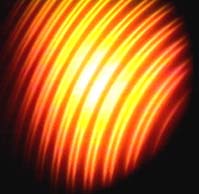Sodium Doublet on Fabrey-Perot
The image below shows the appearance of the interference fringes of the sodium doublet produced by Fabry-Perot optics. This is the appearance at one position.

|
As the micrometer is adjusted to increase the mirror spacing, the appearance changes as the fringes merge together. If the micrometer is advanced until the fringes look the same again, then you have advanced one of the fringe sets one full order with respect to the other. This allows you to calculate the wavelength difference. |
Index | |
| HyperPhysics***** Physics 3901 ***** H/D Doublet | Go Back |
Optimizing H/D FringesMeasurement of the H/D doublet is a difficult task and requires an optimized Fabry-Perot Interferometer. The following are helpful experimental steps. 1. Use a spectra tube with a mixture of hydrogen and deuterium. Although such a tube should not be left on at maximum intensity for long periods, it will be helpful to have maximum brightness during your actual measurements. Darkening the room as much as possible will help. 2. Using a piece of ground glass clamped in the mirror stand closest to the spectral tube will spread the light and help make the fringes visible. Without the ground glass, you tend to just see the shape of the spectral tube and it is difficult to see the fringes. 3. Use the interference filter which is centered on the hydrogen red line to eliminate other light. It can be mounted on a threaded rod. |
Index |
| HyperPhysics***** Physics 3901 ***** H/D Doublet | Go Back |
H/D DoubletAt first glance it would appear that hydrogen and deuterium would have identical spectra since the energy levels are determined by the electromagnetic force and would not appear to depend upon nuclear mass. There is a slight effect, however, caused by the fact that the nucleus about which the electron orbits is not an infinite mass. The Bohr model of the atom predicts that transitions will occur by electron transition between energy levels, leading to wavelengths:  where m is the mass of the electron. However, since the nucleus has finite mass, this should be replaced by the reduced mass:  |
Index |
| HyperPhysics***** Physics 3901 ***** H/D Doublet | Go Back |
Data Collection for DoubletsWhen two closely spaced doublets exist in the light falling on the Fabrey-Perot mirrors, the interference pattern will be a superposition of two interference patterns. If this pattern is observed and the micrometer screw advanced to move one of the mirrors, you can find a position where the rings due to the weaker line are halfway between those of the stronger line. The procedure is then: |
Index |
| HyperPhysics***** Physics 3901 ***** H/D Doublet | Go Back |
Setting Up the MirrorsThe pair of mirrors which make up the adjustable Fabry-Perot interferometer are on separate magnetic bases which are mounted to a large steel plate. Care must be taken to not bump the mirrors together. A reasonable procedure is as follows: 1. Attach one of the mirrors to the steel plate using its magnetic base. |
Index |
| HyperPhysics***** Physics 3901 ***** H/D Doublet | Go Back |
Making Mirrors ParallelOnce you have done the initial mirror setup for the Fabry-Perot interferometer, adjust the mirrors to be parallel by the following procedure: 1. Set up a helium-neon laser on a lab jack so that it shines through the mirror pair from the side opposite the micrometer adjustment. 2. Turn the adjustment screws until only one point of light is seen leaving the mirror pair. This happens only when the mirrors are parallel. When the mirrors are not parallel, you see a series of bright red dots. As you adjust the screws (two on each mirror), you can get the red dots to converge to one red dot. You also get some much fainter multiple reflection red dots, which will be there even when adjusted to parallel by the above procedure. |
Index |
| HyperPhysics***** Physics 3901 ***** H/D Doublet | Go Back |
Mirror CareThe mirrors of the Fabrey-Perot interferometer are optically flat, half silvered mirrors. The performance of the interferometer depends upon the optical quality of the surfaces. They should never be touched or cleaned with anything except a soft lens brush to brush away dust. Take care not to bump the mirrors during mirror setup. Leave the mirrors a conservative distance apart, align them with a laser, and then bring them closer together using the micrometer screw. |
Index |
| HyperPhysics***** Physics 3901 ***** H/D Doublet | Go Back |
Micrometers and the Backlash ProblemMicrometers typically advance 0.5 mm in one turn of the micrometer head. If that head is divided into 50 divisions, then each division on the head corresponds to 0.01 mm or ten micrometers. Obtaining accurate measurements with a micrometer requires that the head is moved in only one direction during a measurement, because considerable error is introduced by reversing the screw. The slack in the mechanism is considerably larger than 0.01 mm, and the error introduced by reversing the screw is called "backlash error". The micrometer threads are very fine and of high precision, so they should be treated very carefully. Use a gentle, steady torque to rotate the head and never force it. Even a momentary backturn can introduce error, so be careful to apply torque always in the same direction. |
Index |
| HyperPhysics***** Physics 3901 ***** H/D Doublet | Go Back |